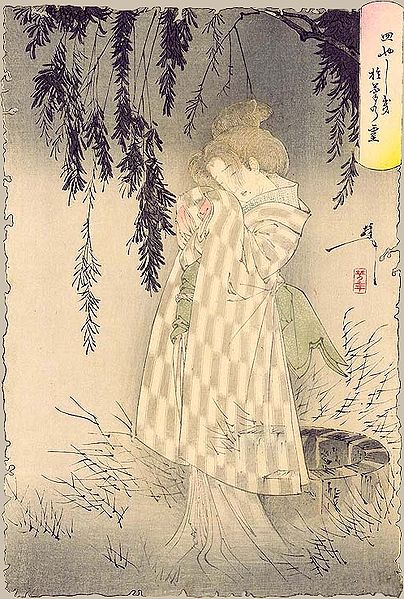 There are three types of ghost in Japan:
obake, youkai and yuurei. Obake literally means “transforming thing” and
it can be used to generally refer to anything weird or grotesque. Yokai
literally means “bewitching apparition” and they include monsters, goblins and
ghouls. Unlike yuurei, which are souls of the dead and “downright scary”, yokai
are comical, bizarre and michievous in some way.
There are three types of ghost in Japan:
obake, youkai and yuurei. Obake literally means “transforming thing” and
it can be used to generally refer to anything weird or grotesque. Yokai
literally means “bewitching apparition” and they include monsters, goblins and
ghouls. Unlike yuurei, which are souls of the dead and “downright scary”, yokai
are comical, bizarre and michievous in some way.Yuurei, is the soul(reikon) of someone wandering around seeking revenge. This is because the person died either by murder, slain in battle, suicide, or the person hasn’t been given an appropriate funeral.
Often said to be haunted by the ghost of Okiku. She is supposed to rise from the well at night and count to nine before shrieking and returning to the well. The ghost story of Okiku, an unfortunate servant maid, is one of the best known and was transformed into a Kabuki play and numerous novels.
Some stories, however, locate the haunted well in the Canadian embassy in Tokyo's garden.
There are different versions of the ghost story of Okiku. What they all have in common is the description of her ghost coming out of the well and counting from one to nine and then breaking out into a heart-rendering sobbing.
In another version, Okiku really breaks a plate and is killed by her master and her corpse is thrown into the well.
In yet another version, it is the wife of Aoyama, who breaks the plate. To hide her guilt, she throws the broken plate into the well and accuses Okiku of having it stolen. In this version she is also killed by her master for punishment and thrown into the well.
There is also an alternate version for the end of the story. To stop the nightly sobbing, a friend of the family of Aoyama is hired. He is hiding at the well during the night and after Okiku had counted from one to nine, he is stepping forward shouting loudly "ten". From then on the ghost of Okiku was never seen again.
In Japanese culture, ghosts take on many different forms. Yuurei are ghosts whose deaths came about so suddenly that they did not have time to make their peace, either because they were murdered or committed suicide rashly (defeated warriors in Japan were often forced to commit suicide). This is the tale of a woman who was so deeply wronged in life that, after more than four hundred years, her soul remains hostage to the agony of the betrayal that killed her. Himeji Castle is an imposing wooden structure, extremely well preserved despite its age. It stands on an elevated position in the center of town of Himeji, thirty miles west of Kobe. The castle's earliest origins are in the early fourteenth century, but it is in the seventeenth century, at a time when the local Shogun government commissioned the tower to be built to its five-story height, that this story is set. At the foot of the tower, known as the Donjon, and located next to the Hara-kiri Maru (the Suicide Gate), where people were forced to commit ritual disembowelment stands the castle well. Its proximity to the gate is no mere coincidence; it was not a source of drinking water, but a means of washing away the blood of a hara-kiri suicide. Today it is known as Okiku's Well.
The story also forms the basis for a number of books and movies. Most notably the story is also the inspiration for the 1998 Japanese horror mystery film, Ring (リング Ringu) adapted from the novel of the same name.
No comments:
Post a Comment